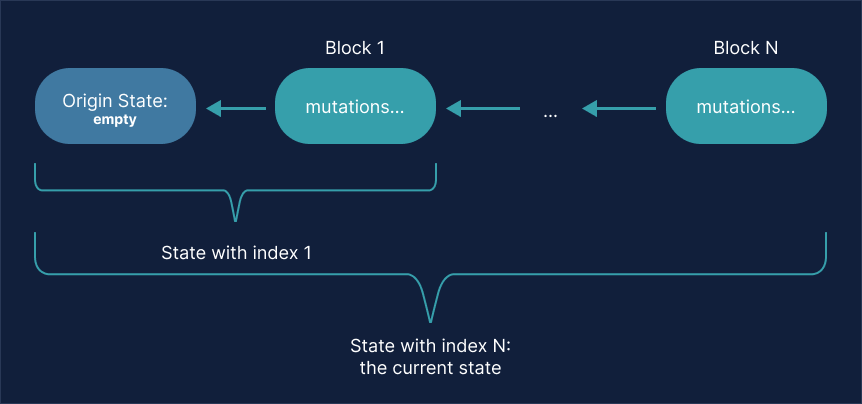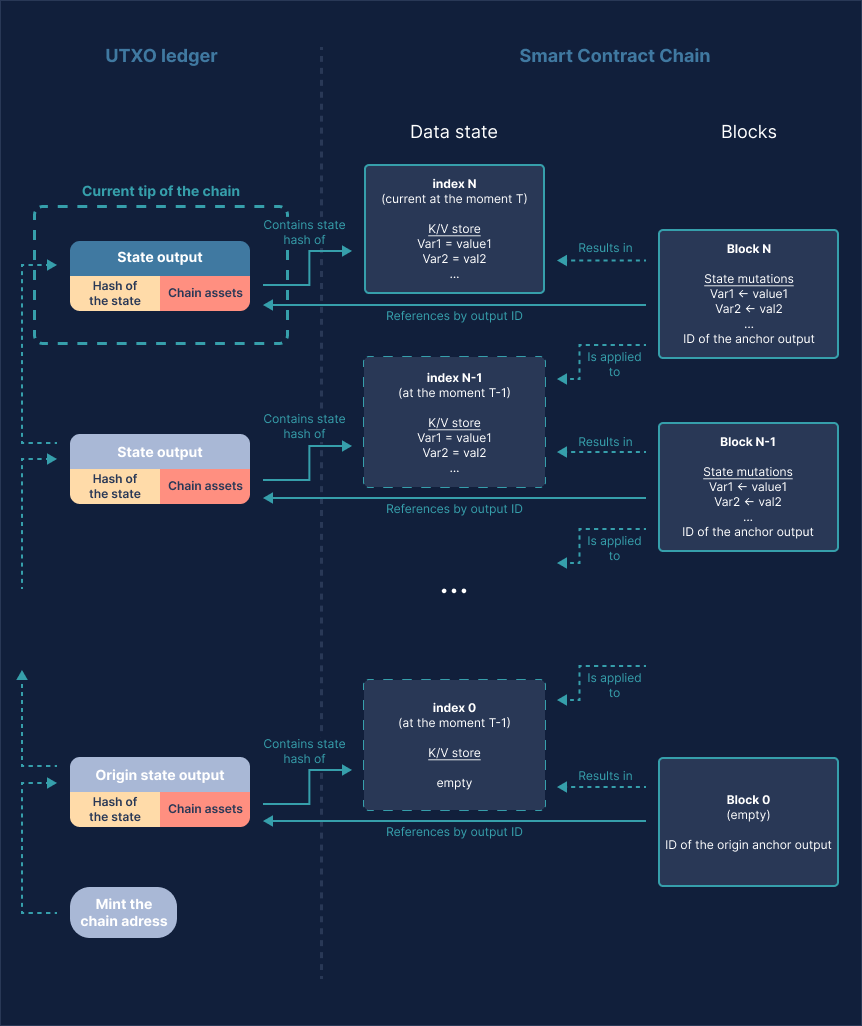State, Transitions, and State Anchoring
State of the Chain
The state of the chain consists of:
- A ledger of accounts owning IOTA digital assetsDigital possessions or resources, such as cryptocurrencies or tokens. (base tokens, native tokens, and NFTs). The chain acts as a custodian for those funds on behalf of each account's owner.
- A collection of arbitrary key/value pairs (the data state) that contains use case-specific data stored by the smart contracts in the chain.
The chain's state is an append-only (immutable) data structureA data structure is a way of organizing data so that it can be efficiently and effectively used. The Tangle uses a variety of data structures, including blocks, payloads, transactions, and commitments, to store and process data. maintained by the distributed consensus of its validators.
Digital Assets on the Chain
Each native L1 account in the IOTA UTXO ledger is represented by an address and controlled by an entity holding the corresponding private/public key pair. In the UTXO ledger, an account is a collection of UTXOs belonging to the address.
Each ISC L2 chain has a L1 account, called the chain account, holding all tokens entrusted to the chain in a single UTXO, the state output. It is similar to how a bank holds all deposits in its vault. This way, the chain (the entity controlling the state output) becomes a custodian for the assets owned by its clients, similar to how the bank’s client owns the money deposited in the bank.
The consolidated assets held in the chain are the total assets on-chain, which are contained in the state output of the chain.
The chain account is controlled by a chain address, also known as chain ID. It is a special kind of L1 address, an alias address, which abstracts the controlling entity (the state controller address) from the identity of the chain: the controlling entity of the chain may change, while the chain ID stays the same.
The Data State
The data state of the chain consists of a collection of key/value pairs. Each key and each value are arbitrary byte arrays.
In its persistent form, the data state is stored in a key/value database outside the UTXO ledger and maintained by the validator nodes of the chain. The state stored in the database is called the solid state.
While a smart contract request is being executed, the virtual state is an in-memory collection of key/value pairs that can become solid upon being committed to the database. An essential property of the virtual state is the possibility of having several virtual states in parallel as candidates, with a possibility for one of them to be solidified.
The data state has a state hash, a timestamp, and a state index. The state hash is usually a Merkle root, but it can be any hashing function of all data in the data state.
The data state hash and on-chain assets are contained in a single atomic unit on the L1 ledger: the state UTXO. Each state mutation (state transition) of the chain is an atomic event that changes the on-chain assets and the data state, consuming the previous state UTXO and producing a new one.
Anchoring the State
The data state is stored outside the ledger, on the distributed database maintained by validatorA validator is a participant in a Proof of Stake (PoS) network that stake their tokens in order to validate transactions and blocks and maintain the security of the DLT/blockchain. nodes. Anchoring the state means placing the hash of the data state into the state UTXO and adding it to the L1 UTXO ledger. The UTXO ledger guarantees that there is exactly one such output for each chain on the ledger at every moment. We call this output the state output (or state anchor) and the containing transaction the state transaction (or anchor transaction) of the chain. The state output is controlled (i.e., can be unlocked/consumed) by the entity running the chain.
With the anchoring mechanism, the UTXO ledger provides the following guarantees to the IOTA Smart Contracts chain:
- There is a global consensus on the state of the chain
- The state is immutable and tamper-proof
- The state is consistent (see below)
The state output contains:
- The identity of the chain (its L1 alias address)
- The hash of the data state
- The state index, which is incremented with each new state output
State Transitions
The data state is updated by mutations of its key/value pairs. Each mutation either sets a value for a key or deletes a key (and the associated value). Any update to the data state can be reduced to a partially ordered sequence of mutations.
A blockData objects processed by nodes: they contain single transactions. A block is composed of 1) block header (auxiliary information to identify the block); 2) transaction/data; 3) signature. is a collection of mutations to the data state that is applied in a state transition:
next data state = apply(current data state, block)
The state transition in the chain occurs atomically in a L1 transaction that consumes the previous state UTXO and produces the next one. The transaction includes the movement of the chain's assets and the update of the state hash,
At any moment in time, the data state of the chain is a result of applying the historical sequence of blocks, starting from the empty data state.

On the L1 UTXO ledger, the state's history is represented as a sequence (chain) of UTXOs, each holding the chain’s assets in a particular state and the anchoring hash of the data state. Note that not all the state's transition history may be available: due to practical reasons, older transactions may be pruned in a snapshot process. The only thing guaranteed is that the tip of the chain of UTXOs is always available (which includes the latest data state hash).
The ISC virtual machine (VM) computes the blocks and state outputs that anchor the state, which ensures that the state transitions are calculated deterministically and consistently.
